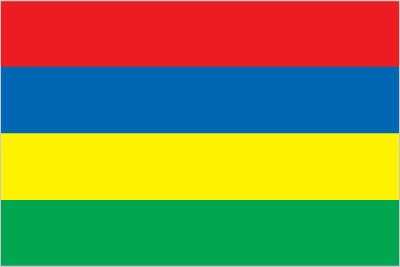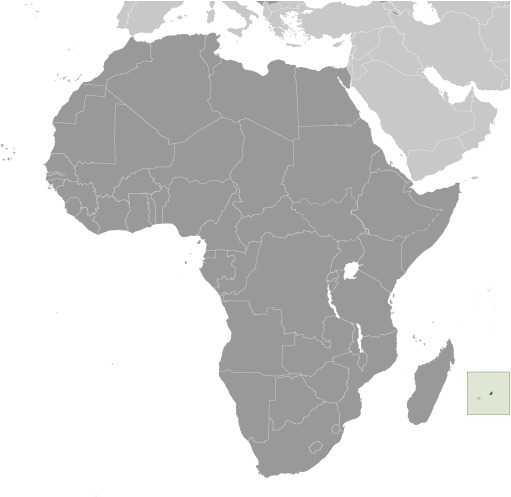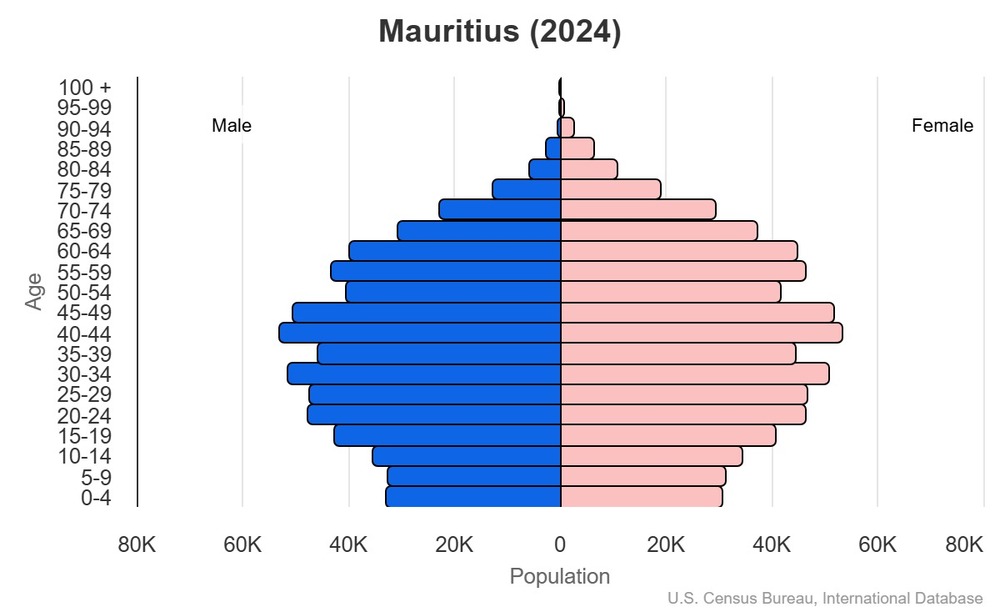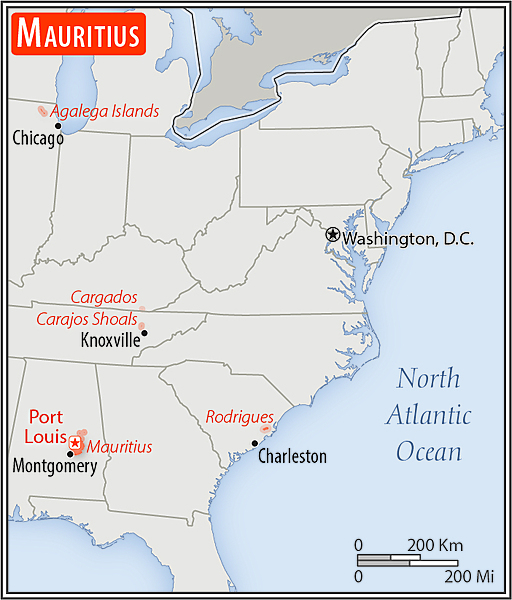Mauritius - MU - MUS - MRI - Africa



Mauritius Images
Mauritius Factbook Data
Diplomatic representation from the US
embassy: 4th Floor, Rogers House, John Kennedy Avenue, Port Louis
mailing address: 2450 Port Louis Place, Washington, DC 20521-2450
telephone: [230] 202-4400
FAX: [230] 208-9534
email address and website:
PTLConsular@state.gov
https://mu.usembassy.gov/
Age structure
15-64 years: 71% (male 462,833/female 467,509)
65 years and over: 13.9% (2024 est.) (male 75,464/female 107,014)

For additional information, please see the entry for Population pyramid on the Definitions and Notes page.
Geographic coordinates
Sex ratio
0-14 years: 1.04 male(s)/female
15-64 years: 0.99 male(s)/female
65 years and over: 0.71 male(s)/female
total population: 0.95 male(s)/female (2024 est.)
Natural hazards
Area - comparative

almost 11 times the size of Washington, DC
Background
Although known to Arab and European sailors since at least the early 1500s, the island of Mauritius was uninhabited until 1638 when the Dutch established a settlement named in honor of Prince Maurits van NASSAU. Their presence led to the rapid disappearance of the flightless dodo bird that has since become one of the most well-known examples of extinction in modern times. The Dutch abandoned their financially distressed settlement in 1710, although a number of formerly enslaved people remained. In 1722, the French established what would become a highly profitable settlement focused on sugar cane plantations that were reliant on the labor of enslaved people brought to Mauritius from other parts of Africa. In the 1790s, the island had a brief period of autonomous rule when plantation owners rejected French control because of laws ending slavery that were temporarily in effect during the French Revolution. Britain captured the island in 1810 as part of the Napoleonic Wars but kept most of the French administrative structure, which remains to this day in the form of the country’s legal codes and widespread use of the French Creole language. The abolition of slavery in 1835 -- later than most other British colonies -- led to increased reliance on contracted laborers from the Indian subcontinent to work on plantations. Today their descendants form the majority of the population. Mauritius remained a strategically important British naval base and later an air station, and it played a role during World War II in anti-submarine and convoy operations, as well as in the collection of signals intelligence.
Mauritius gained independence from the UK in 1968 as a Parliamentary Republic and has remained a stable democracy with regular free elections and a positive human rights record. The country also attracted considerable foreign investment and now has one of Africa's highest per capita incomes. Mauritius’ often-fractious coalition politics has been dominated by two prominent families, each of which has had father-son pairs who have been prime minister over multiple, often nonconsecutive, terms. Seewoosagur RAMGOOLAM (1968-76) was Mauritius’ first prime minister, and he was succeeded by Anerood JUGNAUTH (1982-95, 2000-03, 2014-17); his son Navin RAMGOOLAM (1995-2000, 2005-14); and Paul Raymond BERENGER (2003-05), the only non-Hindu prime minister of post-independence Mauritius. In 2017, Pravind JUGNAUTH became prime minister after his father stepped down short of completing his term, and he was elected in his own right in 2019.
Mauritius claims the French island of Tromelin and the British Chagos Archipelago (British Indian Ocean Territory). Since 2017, Mauritius has secured favorable UN General Assembly resolutions and an International Court of Justice advisory opinion relating to its sovereignty dispute with the UK.
Environmental issues
International environmental agreements
signed, but not ratified: none of the selected agreements
Population below poverty line
note: % of population with income below national poverty line
Household income or consumption by percentage share
highest 10%: 29.9% (2017 est.)
note: % share of income accruing to lowest and highest 10% of population
Exports - commodities
note: top five export commodities based on value in dollars
Exports - partners
note: top five export partners based on percentage share of exports
Administrative divisions
Agricultural products
note: top ten agricultural products based on tonnage
Military and security forces
Budget
expenditures: $5.042 billion (2024 est.)
note: central government revenues (excluding grants) and expenditures converted to US dollars at average official exchange rate for year indicated
Capital
geographic coordinates: 20 09 S, 57 29 E
time difference: UTC+4 (9 hours ahead of Washington, DC, during Standard Time)
etymology: named after LOUIS XV, who was king of France in 1736 when the port became the administrative center of Mauritius
Imports - commodities
note: top five import commodities based on value in dollars
Climate
Coastline
Constitution
amendment process: proposed by the National Assembly; passage of amendments affecting constitutional articles, including the sovereignty of the state, fundamental rights and freedoms, citizenship, or the branches of government, requires approval in a referendum by at least three-fourths majority of voters followed by a unanimous vote by the Assembly; passage of other amendments requires only two-thirds majority vote by the Assembly
Exchange rates
Exchange rates:
46.415 (2024 est.)
45.267 (2023 est.)
44.183 (2022 est.)
41.692 (2021 est.)
39.347 (2020 est.)
Executive branch
head of government: Prime Minister Navin RAMGOOLAM (since 13 November 2024)
cabinet: Cabinet of Ministers (Council of Ministers) appointed by the president on the recommendation of the prime minister
election/appointment process: president and vice president indirectly elected by the National Assembly for 5-year renewable terms; the president appoints the prime minister and deputy prime minister who have the majority support in the National Assembly
most recent election date: 7 November 2019
election results:
2019: Prithvirajsing ROOPUN (MSM) elected president by the National Assembly - unanimous vote
2015: Ameenah GURIB-FAKIM (independent) elected president by the National Assembly - unanimous vote
expected date of next election: 2024
Flag
meaning: red stands for self-determination and independence; blue for the Indian Ocean; yellow for the new light of independence, golden sunshine, or the bright future; and green for agriculture or the island's lush vegetation
note: Mauritius has the only national flag with four horizontal color bands
Independence
Industries
Judicial branch
judge selection and term of office: chief justice appointed by the president after consultation with the prime minister; senior puisne judge appointed by the president with the advice of the chief justice; other puisne judges appointed by the president with the advice of the Judicial and Legal Commission, a 4-member body of judicial officials including the chief justice; all judges serve until retirement at age 67
subordinate courts: lower regional courts known as District Courts, Court of Civil Appeal; Court of Criminal Appeal; Public Bodies Appeal Tribunal
note: the Judicial Committee of the Privy Council (in London) serves as the final court of appeal
Land boundaries
Land use
arable land: 37.6% (2023 est.)
permanent crops: 2% (2023 est.)
permanent pasture: 3.5% (2023 est.)
forest: 19.2% (2023 est.)
other: 37.8% (2023 est.)
Legal system
Legislative branch
legislative structure: unicameral
chamber name: National Assembly
number of seats: 67 (62 directly elected; 4 appointed)
electoral system: plurality/majority
scope of elections: full renewal
term in office: 5 years
most recent election date: 11/10/2024
parties elected and seats per party: Alliance Du Changement (Alliance for Change, AdC) (60); Other (2)
percentage of women in chamber: 17.9%
expected date of next election: October 2029
Literacy
male: 96.3% (2023 est.)
female: 92.8% (2023 est.)
Maritime claims
exclusive economic zone: 200 nm
continental shelf: 200 nm or to the edge of the continental margin
note: measured from claimed archipelagic straight baselines
International organization participation
National holiday
note: became independent and a republic on the same date in 1968 and 1992, respectively
Nationality
adjective: Mauritian
Natural resources
Geography - note
Economic overview
Political parties
Jean-Claude Barbier Movement (Mouvement Jean-Claude Barbier) or MJCB
Mauritian Militant Movement (Mouvement Militant Mauricien) or MMM
Mauritian Social Democratic Party (Parti Mauricien Social Democrate) or PMSD
Mauritius Labor Party (Parti Travailliste) or PTR or MLP
Militant Platform (Plateforme Militante) or PM
Militant Socialist Movement (Mouvement Socialist Mauricien) or MSM
Muvman Liberater or ML
National Alliance
Patriotic Movement (Mouvement Patriotique) or MAG
Rodrigues Peoples Organization (Organisation du Peuple Rodriguais) or OPR
Suffrage
Terrain
Government type
Country name
conventional short form: Mauritius
local long form: Republic of Mauritius
local short form: Mauritius
etymology: named after Prince Maurice VAN NASSAU, stadtholder (governor) of the Dutch Republic, in 1598
note: pronounced mahr-ish-us
Location
Map references
Irrigated land
Diplomatic representation in the US
chancery: 1709 N Street NW, Washington, DC 20036
telephone: [1] (202) 244-1491
FAX: [1] (202) 966-0983
email address and website:
mauritius.embassy@verizon.net
https://mauritius-washington.govmu.org/Pages/index.aspx
Internet users
Internet country code
GDP (official exchange rate)
note: data in current dollars at official exchange rate
Total renewable water resources
School life expectancy (primary to tertiary education)
male: 14 years (2020 est.)
female: 15 years (2020 est.)
Urbanization
rate of urbanization: 0.28% annual rate of change (2020-25 est.)
Broadcast media
Drinking water source
urban: 100% of population (2022 est.)
rural: 100% of population (2022 est.)
total: 100% of population (2022 est.)
unimproved:
urban: 0% of population (2022 est.)
rural: 0% of population (2022 est.)
total: 0% of population (2022 est.)
National anthem(s)
lyrics/music: Jean Georges PROSPER/Philippe GENTIL
history: adopted 1968
Major urban areas - population
International law organization participation
Physician density
Hospital bed density
National symbol(s)
GDP - composition, by end use
government consumption: 14.7% (2024 est.)
investment in fixed capital: 21% (2024 est.)
investment in inventories: 0.2% (2024 est.)
exports of goods and services: 46.2% (2024 est.)
imports of goods and services: -57.8% (2024 est.)
note: figures may not total 100% due to rounding or gaps in data collection
Dependency ratios
youth dependency ratio: 21.2 (2024 est.)
elderly dependency ratio: 19.6 (2024 est.)
potential support ratio: 5.1 (2024 est.)
Citizenship
citizenship by descent only: yes
dual citizenship recognized: yes
residency requirement for naturalization: 5 out of the previous 7 years including the last 12 months
Population distribution
Electricity access
electrification - urban areas: 99%
electrification - rural areas: 100%
Civil aircraft registration country code prefix
Sanitation facility access
urban: 99.7% of population (2022 est.)
unimproved:
urban: 0.3% of population (2022 est.)
Ethnic groups
note: Mauritius has not had a question on ethnicity on its national census since 1972
Religions
Languages
Imports - partners
note: top five import partners based on percentage share of imports
Refugees and internally displaced persons
IDPs: 39 (2024 est.)
Elevation
lowest point: Indian Ocean 0 m
Health expenditure
9.4% of national budget (2022 est.)
Military - note
the Special Mobile Force was created in 1960 following the withdrawal of the British garrison (2025)
Total water withdrawal
industrial: 10 million cubic meters (2022)
agricultural: 303 million cubic meters (2022)
Waste and recycling
percent of municipal solid waste recycled: 15.9% (2022 est.)
National heritage
selected World Heritage Site locales: Aapravasi Ghat; Le Morne Cultural Landscape
Coal
imports: 610,000 metric tons (2023 est.)
Electricity generation sources
solar: 4.6% of total installed capacity (2023 est.)
wind: 0.3% of total installed capacity (2023 est.)
hydroelectricity: 2.9% of total installed capacity (2023 est.)
biomass and waste: 9.9% of total installed capacity (2023 est.)
Petroleum
Currently married women (ages 15-49)
Remittances
2.1% of GDP (2022 est.)
2.4% of GDP (2021 est.)
note: personal transfers and compensation between resident and non-resident individuals/households/entities
Ports
large: 0
medium: 0
small: 1
very small: 1
ports with oil terminals: 1
key ports: Port Louis, Port Mathurin
National color(s)
Particulate matter emissions
Labor force
note: number of people ages 15 or older who are employed or seeking work
Youth unemployment rate (ages 15-24)
male: 15.3% (2024 est.)
female: 18.4% (2024 est.)
note: % of labor force ages 15-24 seeking employment
Debt - external
note: present value of external debt in current US dollars
Maternal mortality ratio
Reserves of foreign exchange and gold
$7.248 billion (2023 est.)
$7.793 billion (2022 est.)
note: holdings of gold (year-end prices)/foreign exchange/special drawing rights in current dollars
Public debt
note: central government debt as a % of GDP
Unemployment rate
5.6% (2023 est.)
6.4% (2022 est.)
note: % of labor force seeking employment
Population
male: 639,270
female: 671,234
Carbon dioxide emissions
from coal and metallurgical coke: 1.495 million metric tonnes of CO2 (2023 est.)
from petroleum and other liquids: 4.056 million metric tonnes of CO2 (2023 est.)
Area
land: 2,030 sq km
water: 10 sq km
note: includes Agalega Islands, Cargados Carajos Shoals (Saint Brandon), and Rodrigues
Taxes and other revenues
note: central government tax revenue as a % of GDP
Real GDP (purchasing power parity)
$32.864 billion (2023 est.)
$31.296 billion (2022 est.)
note: data in 2021 dollars
Airports
Telephones - mobile cellular
subscriptions per 100 inhabitants: 161 (2022 est.)
Gini Index coefficient - distribution of family income
note: index (0-100) of income distribution; higher values represent greater inequality
Inflation rate (consumer prices)
7.1% (2023 est.)
10.8% (2022 est.)
note: annual % change based on consumer prices
Current account balance
-$1.437 billion (2022 est.)
-$1.497 billion (2021 est.)
note: balance of payments - net trade and primary/secondary income in current dollars
Real GDP per capita
$26,100 (2023 est.)
$24,800 (2022 est.)
note: data in 2021 dollars
Broadband - fixed subscriptions
subscriptions per 100 inhabitants: 27 (2023 est.)
Tobacco use
male: 37.4% (2025 est.)
female: 2.6% (2025 est.)
Obesity - adult prevalence rate
Energy consumption per capita
Electricity
consumption: 3.084 billion kWh (2023 est.)
transmission/distribution losses: 179.996 million kWh (2023 est.)
Merchant marine
by type: general cargo 1, oil tanker 4, other 27
Imports
$8.052 billion (2022 est.)
$6.057 billion (2021 est.)
note: balance of payments - imports of goods and services in current dollars
Exports
$6.138 billion (2022 est.)
$4.213 billion (2021 est.)
note: balance of payments - exports of goods and services in current dollars
Heliports
Telephones - fixed lines
subscriptions per 100 inhabitants: 36 (2023 est.)
Alcohol consumption per capita
beer: 1.94 liters of pure alcohol (2019 est.)
wine: 0.23 liters of pure alcohol (2019 est.)
spirits: 0.88 liters of pure alcohol (2019 est.)
other alcohols: 0.03 liters of pure alcohol (2019 est.)
Life expectancy at birth
male: 72.6 years
female: 78.4 years
Real GDP growth rate
5% (2023 est.)
8.7% (2022 est.)
note: annual GDP % growth based on constant local currency
Industrial production growth rate
note: annual % change in industrial value added based on constant local currency
GDP - composition, by sector of origin
industry: 17.8% (2024 est.)
services: 64.4% (2024 est.)
note: figures may not total 100% due to non-allocated consumption not captured in sector-reported data
Education expenditure
14.2% national budget (2024 est.)
Gross reproduction rate
Net migration rate
Median age
male: 38.1 years
female: 41 years
Total fertility rate
Infant mortality rate
male: 13.1 deaths/1,000 live births
female: 10 deaths/1,000 live births
